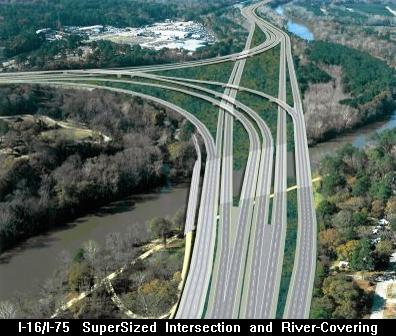
Eisenhower Parkway
Extension , Caution
Macon
the
Macon
Levee
Betrayal of
Pleasant Hill Community 2016
Interstate 16 and
Interstate 75 - a proposed
SuperSizing - in Macon, Georgia
is the GDOT plan really
safer?
i16i75-Design-Approved-2010-October

|
28 August 2008
The improvement of the I-16 / I-75 interchange in the heart of Macon, Georgia has been a topic of discussion since it was originally built some forty years ago. It has been an actively-studied project for the Georgia Department of Transportation since 1994. It is a given that the interchange needs to be made safer. The design elements of it, including exits too close to curves and too-short exit ramps, need improving. On this everyone agrees.
That is why more than fifty community organizations have joined together to ask, once again, for a more common sense, less destructive approach to our transportation needs. These organizations represent a broad spectrum of our community but they have one thing in common – an abiding interest in the betterment of Macon. They have come together in this unprecedented endeavor to ask your help in bringing balance to this process.
Sincerely, James H. Webb, chair Citizens Coalition for Common Sense Interstates, Macon
|
||
|
Citizens Coalition for Common Sense Interstates Macon
Macon Community Call to GDOT and FHWA for an Environmental Impact Statement and Regionally-Appropriate, Context-Sensitive Redesign of the I-16 / I-75 Interchange
We, the undersigned, preserve, protect, articulate and interpret Macon’s culturally and historically vital assets and are charged with maintaining and enhancing Macon’s quality of life. We call for the reconsideration and a more context-sensitive redesign of the I-16 / I-75 interchange in the heart of our community as currently proposed by the Georgia Department of Transportation. There is no doubt that the existing interchange was poorly designed and needs improvement. However, the planned redesign for this interchange will so negatively impact our community that it is not an acceptable solution. We contend that the needs and wishes of our community, as well as the ebb and flow of the interstate, should be equally considered when re-working and improving the transportation system through our city. The current redesign gives very little accommodation to Macon as a vital and enduring community and, in fact, will irreparably harm many of our most important cultural and historic assets and neighborhoods.
The connection of I-16 and I-75 in the heart of Macon has played an important economic part in our prosperity. However, that connection came at a heavy community cost. It severed, physically and psychologically, the heart of Macon from its body. The interstate’s extensive construction in the Ocmulgee’s floodway, coupled with the project’s raising of the Macon Levee, increased the likelihood of more frequent and more damaging floods in our community. The Ocmulgee National Monument and Ocmulgee Old Fields Traditional Cultural Property, as well as historic Rose Hill, Riverside and Linwood Cemeteries, were severely impacted and the proposed redesign will increase ongoing degradations. I-16 / I-75 wiped out entire neighborhoods, isolating the remaining areas and causing widespread deterioration in our central city. Historic East Macon (including the historic districts of Shirley Hills, North Highlands and Fort Hill), historic Pleasant Hill, the historic Vineville / Ingleside area, Winship Hills and the Ocmulgee River, itself, were separated from the historic Intown neighborhood, and from downtown, with expansive swaths of concrete. Much of Macon’s historic and important connectivity was lost forever. A half-century later we are just beginning to address the problems associated with the initial building of these interstates. The interchange redesign, as now proposed, will do nothing to enhance our community. It will, instead, do further physical, visual and audile damage to the fragile historic neighborhoods which will be impacted by this mammoth construction project. It is of paramount importance to the future of our community that any and all future remedies are well-thought-out and comprehensive in approach so that further harm is not done.
One of Macon’s most important economic engines is heritage and cultural tourism. Our cultural and historical assets make Macon unique and appealing to residents and tourists alike. Our community is widely admired for its connection with its past and is nationally known for its historic preservation successes. No small part of this is our ongoing efforts to revitalize our historic downtown, its adjacent neighborhoods and our riverfront. These revitalization efforts are at a critical juncture and enormous amounts of private and public funds are being invested. In addition, our important museum-district, as well as our several house-museums, are facing difficult times. Now is not the time to sabotage them with the building of such an ill-conceived impediment. The building of a massive, 12-lane (or more),interchange, at dizzying heights, with a huge footprint, adjacent to and, in fact, at the entrance to many of Macon’s historic and cultural assets is not compatible with these long-term plans and aspirations. The excessive design and size of the proposed interchange is anathema to the identity of Macon as a progressive and historic community. Instead of improving access to our resurgent downtown it will, by design and because of the length of time our roads will be in turmoil, make it substantially more difficult to get there. Instead of promoting tourism, with appealing and appropriate access to our many struggling museums and events, this over-built design will serve as a defacto “detour” sign driving visitors away, figuratively and literally.
We, therefore, ask for a new and thoughtful approach to our regional transportation needs. The current approach to solving the design problems of this interchange is too focused on the ill-conceived interchange itself and should be broadened to include regional, long-term solutions to the transportation systems in and around Macon. This new approach should focus on improving the connectivity of the road systems without overbuilding, without unnecessary and insensitive destruction, without endangering our historic and cultural assets, and without further damaging our historic neighborhoods. The solutions should enhance our community, rather than diminish its quality of life. The solutions should no longer turn a blind eye to the issues of environment and environmental justice. The new approach should include comprehensive regional planning for future harmonious growth in Middle Georgia. And, the concerns of Macon’s citizens should be given full consideration instead of the short-shrift that has been cynically offered thus far.
The interstate system is an important element in the American way of life and contributes immeasurably to it. However, the needs of the interstate-traveling public cannot outweigh the needs of the local communities through which the highways are routed. A balance must be found which accomplishes the interstate’s through-connection in a manner which does not further harm our community. We respectfully request reconsideration and redesign of these projects, with a full, federally-mandated, Environmental Impact Statement. We believe that a new, thoughtful and context-sensitive regional approach, combined with better and more progressive transportation thinking, will result in more fairly-balanced solutions for the needs of the interstate system and for our community.
What we seek is a win-win outcome. And we call on all those involved, on all levels, to address this situation with the respect our community deserves.
Altamaha Riverkeeper A T Long and Son Contractors Big House Foundation Big “O” Foundation Bragg Jam Brown’s Mount Association Cannonball House Caution Macon Changing Macon Social Club Cherry Blossom Festival Citizens Advisory Committee / MATS Douglass Theatre Eleventh Hour Federated Garden Clubs of Macon Friends of Fort Hawkins Georgia Chapter of the Sierra Club Georgia Children’s Museum Georgia Music Hall of Fame Foundation Georgia Sports Hall of Fame Georgia Trust for Historic Preservation Hay House High Street Unitarian Universalist Church Historic Macon Foundation Historic Rose Hill Cemetery Foundation Huguenin Heights Neighborhood I-16 / I-75 Improvement Project Advisory Committee of GDOT Intown Macon Neighborhood Association James and Jodi Palmer, Publishers Junior League of Macon Keep Macon-Bibb Beautiful Commission Macon Arts Macon-Bibb NAACP Macon Cemetery Preservation Corporation Macon Civic Club Macon Film and Video Festival (MAGA) Macon Independent Restaurant Association Macon Symphony Orchestra Macon Tree Commission Madison / Poss Museum of Arts and Sciences North Highlands Neighborhood Riverside Cemetery Rosa Taylor Area Neighborhood Watch Shirley Hills Neighborhood Sidney Lanier Cottage Sierra Club- Ocmulgee Chapter St. Peter Claver School Temple Beth Israel The Black Pages Theatre Macon Vineville United Methodist Church Vineville Neighborhood Association We Care Group Winship Hills Neighborhood
|
||
Sherman
spared
Macon...Why can't GDOT?
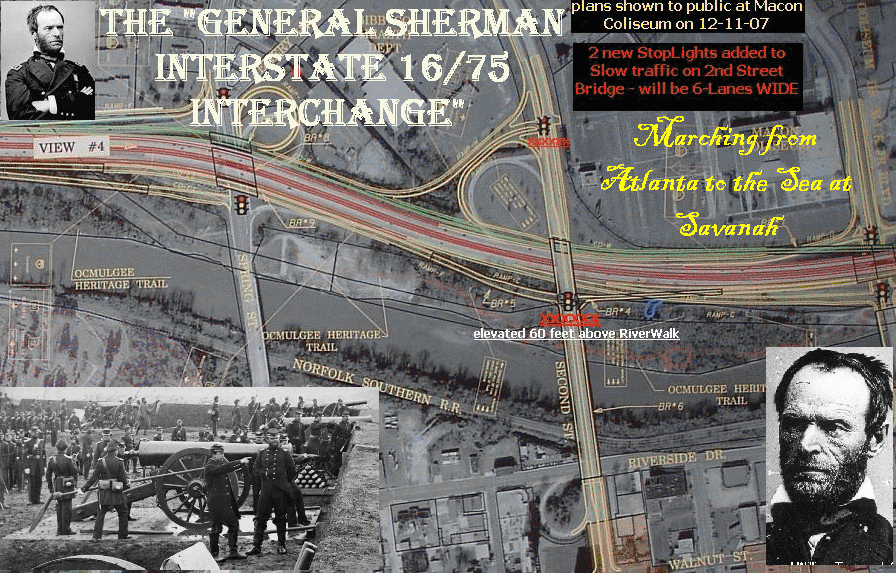
|
Stop
The Monster ! |
|||||||

|
|||||||
|
Remarks
to
Macon City Council
from the Chairman of the Citizens Advisory Committee of Macon Area Transportation Study group on 7-1-08
I would like to address you as a concerned citizen. I also am speaking for an informal grass roots coalition of cultural, arts and historic organizations; museums and house museums; tourism proponents and tourist attractions; historic cemeteries and neighborhoods; environmentalists; churches and schools; and many, many other concerned Macon citizens. Within the next week or so we will be presenting to the court of public opinion a comprehensive statement which will, in great detail, innumerate the economic, environmental and ethical objections that the City of Macon should have, and which most of the citizens of Macon already have, to the proposed I-16/I-75 interchange project as currently proposed by the Georgia Department of Transportation.
The Macon City Council has already, twice, voted unanimously to ask the GDOT to redesign this project and make it more in keeping with the scale and character of Macon and more responsive to the wishes of Macon’s citizens. Both of those resolutions have fallen on deaf ears. No substantive changes have been made to the project to reign-in the wasteful and destructive aspects of what is proposed. It is still too big, too wide, too tall, too destructive and too confusing. It is still out-of-character for our community. It is still grossly overbuilt and unnecessary in its proposed scale. And, the price has escalated and is hovering around half a billion dollars. The waste of tax-payer money is unconscionable.
There was a “stake-holders” committee established by GDOT for this project. That committee never voted to approve the design and, in fact, voted to oppose the mammoth “spaghetti junction” concept.
Several public forums were held where various confusing designs were presented for public comment. Overwhelming public dissatisfaction with the designs was totally ignored. Cynically, neighborhoods in differing areas of town have been played off one another to diffuse opposition.
The Federal Highway Administration’s own rules dictate that a full Environmental Impact Statement should be undertaken “for major Federal actions which significantly affect the quality of the human condition”. Yet, this was also ignored and, instead, the design consultants were asked to do a much less stringent and comprehensive Environmental Assessment.
We in Macon are in the midst of a big chess game. The road builders have taken the advantage and are making clever strategic moves to ensure that they prevail. It is clear that there would be major environmental problems with this project related to the flood plane and the ongoing levee situation. It is clear that the design is intended to pull higher-speed traffic through our city – creating ever more “non-attaining” air pollution problems. It is fact that simple signage “tweaking” has drastically reduced the accident count on the interstate and that further, sensitive minor redesigns will have just as favorable results. It is clear there will be serious erosion of historic and cultural assets in Macon’s historic areas and that it will negatively impact downtown revitalization. It is clear there will be major environmental justice issues related to historic Pleasant Hill and to East Macon. By promising this group one thing, and another group another thing, the road builders have cleverly bought silence on any number of thorny issues.
The resolutions you are considering today are part of that attempt to “cook the books” before this project is submitted to Federal Highway. If they can get the City of Macon to agree that the proposed mitigation efforts for Pleasant Hill are acceptable, in exchange for forever degrading the very character of Macon and its quality of life, then they have one more brick with which to build the “inevitability” we keep being told is already a fact in this situation.
It is very important to not be swayed by the tactic of accepting, piecemeal, the various elements of this unbelievably destructive road “improvement”. By drawing this committee’s focus to a few new green spaces and other so-called neighborhood improvements for Pleasant Hill, which have been promised to “mitigate” (that’s a bureaucratic word for “bribe”) the full-tilt destruction the project will be bringing to Macon itself, the road builders are hoping to “divide and conquer” our city, and erode your earlier objections to the project as a whole. [As an aside, I ask you to consider just how pleasant these new green spaces will be, even if you could figure out how to afford to maintain them – walled off and in the shadow of extremely tall, prison-like, sound barrier walls (which only dilute the sound for a short distance) which will also block the breeze and will create unseen zones which will, undoubtedly, act as magnets for criminal activity. Is a slightly-wider pedestrian bridge really worth walling off a neighborhood with big, ugly sound barriers?]
But, today you can stand up for what is right for Macon, Georgia. Full Council has already done it twice. We ask you to do so again. This project is only “inevitable” if you let it be. You can stop it, and force an improved design, today. If you refuse to be hoodwinked, if you refuse to take this bait, you can win a major victory for Macon’s future quality of life. Turn these resolutions down and, instead, insist that a full Environmental Impact Statement be undertaken. Insist that progressive transportation concepts be used for this project. Insist that this project be designed with a regional awareness which will address not just one intersection but will address the needs of our entire community.
James H. Webb Associate Broker, Sheridan Solomon and Associates Realtors 2618 Riverside Drive Macon, GA 31204 Email: jhw@mylink.net Office Telephone: (478)-746-2000 or (800)-329-9980, ext. 322 Office Fax: (478)-746-2003 Pager: (478)-755-3333
|
|||||||
| www.i16i75.com
GDOT
Monster
- Strangling
the Citizens of Macon and Bibb County |
|||||||
Posted on Fri, Dec. 21, 2007 -- http://www.macon.com/198/story/218771.htmlPlans for interchange work offer eye-popping designBy Travis Fain - tfain@macon.comNew decision points for exits are among the biggest changes that drivers will see once the state Department of Transportation reworks the interchange of Interstate 75 and Interstate 16. What that means is that drivers planning to go from I-75 to I-16, Spring Street, Second Street, Coliseum Drive or Hardeman Avenue will have to decide sooner. There are a lot of possibilities and potential exit combinations, depending on which direction you're traveling, but here are the basics: • The I-75 southbound exit onto I-16 would move about 4,000 feet northwest and be much closer to Pierce Avenue. • The I-75 northbound exit onto I-16 would move about 4,000 feet south, essentially to the pedestrian bridge that now crosses the interstate in the Pleasant Hill neighborhood. • The I-16 westbound split into I-75 north and I-75 south would happen before you cross the river instead of after. • The exit onto Spring Street also would move across the river, coming much sooner as you travel I-75, no matter which direction you're going. In fact, you'll have to take the Spring Street exit at the new interchange itself instead of briefly traveling I-16 westbound, as you do now. This is where a series of feeder ramps for upcoming exits begin. All told, the Spring Street exit will move about a mile. • The same would be true of Second Street, because it will share the feeder ramp with Spring Street. • Coliseum Drive's exits also would shift, but not as noticeably as those for Spring and Second streets. • The Hardeman Avenue exit off I-75 would shift about 1.3 miles and would come before the actual interchange between I-16 and I-75. It would stay on the same side of the river, but it would occur before you reach the major interchange instead of after. At this point, project construction is planned for 2012, with right-of-way acquisitions scheduled to begin before next summer. Officials say that it could take five or six years for construction. Totals costs for the project are estimated at more than $300 million. The interchange and river crossing At the point where Interstate 16 crosses the river, the highway will expand from six lanes to 14, once you take into account all the new ramps that will shunt traffic to the various exits near the interchange. Instead of two bridges, there will be seven, though the one on the far left will serve as a pedestrian bridge and bike trail for the riverwalk. During construction that bridge also will be used for temporary traffic lanes. Once complete, the interchange will be one of the largest in Georgia and by far the largest outside of Atlanta. The project's size has been critics' chief complaint, but the interchange is large for a couple of reasons. First, the federal government wanted drivers to exit Interstate 75 southbound onto I-16 to the right, instead of to the left as they do now. Also, there are three local street exits off I-16 within a mile-and-a-half (Spring Street, Second Street and Coliseum Drive) and one off I-75 (the Hardeman Avenue and Forsyth Street exit). To keep people from weaving across lanes to make these exits, the Department of Transportation has split traffic into several new ramps, each separated by concrete barriers. "Those decision points are just too close and too complicated," said Ben Buchan, a DOT engineer and a primary member of the project's design team. "The bulk of this (new construction) is just splitting all those turning movements." Pleasant Hill Thirty-three homes in Pleasant Hill will have to be moved or demolished to make way for the wider Interstate 75, including the boyhood home of music legend Little Richard Penniman, which is on Fifth Avenue. Twenty-one of those homes are now occupied. Many of the houses are on Middle Street, a rundown street on the right side of these pictures. That area will be turned into park land with a walking/biking path along the interstate. The concrete culvert that runs parallel to the interstate on the right side of the 'before' photo will be piped and covered over. Also on the right side, Fourth and Second avenues, which now feed onto Middle Street, will get cul-de-sacs. Woodliff Street, which also connects to Middle Street now, would get a new access ramp up to Walnut Street, which has a bridge crossing the interstate. The large brick building visible near the pedestrian bridge in the 'before' picture is an abandoned Masonic lodge. It also would be demolished for the project. On the left side of the interstate, First Street will get a cul-de-sac and a portion of the road that now connects First Avenue to Second, Third and Fourth avenues will be closed. There has been some talk of moving Little Richard's boyhood home and turning it into a museum, but so far, there are no firm plans to do so. Spring and Second streets There will be new decision points for people who want to exit onto Spring Street or Second Street. There also will be some changes to access from those streets. At Spring Street, you will still be able to get onto a feeder ramp to I-75, similar to the way the two I-16 westbound ramps at Spring Street work now. But you won't be able to get onto I-16 eastbound, which heads toward Savannah, like you can now. As for exiting from the interstate onto Spring Street, that stays the same: access from the interchange off I-75, no access from I-16 westbound. At Second Street there will be more access. You will still be able to get off I-16 eastbound. But you also will be able to access Second Street, via a feeder ramp, from from I-75, which is new. You also will be
able to get onto I-75 (again, via feeder ramps) from
Second Street and
onto I-16 eastbound. Both of those access points are new. |
|||||||
Recent
Comments:
Once again, why not make this an "urban" interstate intersection by reducing and enforcing the speed limit and saving the money. In fact, why don't we all just obey the posted speed limit as it is now, that would go a long way toward addressing any perceived problem.
Jaz - where are all these deaths at the 16/75 interchange? Not at the Pierce on-ramp (which is not part of the design) or at the overpass at second street but at the actual interchange? There have been more deaths on 475 in the past year than at the interchange. The same traffic engineers gave us the current design are working on the "new" interchange. Why not look to some new engineering thought rather than the same old road designs?
Jaz - I see your post here about the intelligence of the Engineers. I have been in the construction business for 47 years. A few weeks ago one of the representative of this engineering firm that you say is so smart said to me "this widening of Forest Hill Road will not increase the water across your property" . He also stated in the same meeting that he could not pipe the storm water to the corner of my property because " water does not turn 90 degrees well". THESE ARE ACTUAL QUOTES! DO NOT TELL ME ABOUT INTELLIGENCE! HE WAS WRONG AND YOU ARE WRONG. I will leave the Doc's comments out of this because I have not read them. But I have read yours and you absolutely wrong!
K, I have seen this states contractors and city workers take 2 years widening a 2 lane surface street and 10-40 people milking the clock sitting around doing nothing. Now they are talking about tampering with the freeway causing more traffic, mayhem and headaches. You got to be kidding. Sure it will give more jobs and more money for 500 or more people to sit around and do nothing, and eventually decide to work on this project, but what about the people who need to get to there destinations and just don't want to sit in there cars waisting gas waiting for the flag guy(s) to get off his/her behinds and let the traffic by. This is just another headache in progress. Get your
bottle water ready, gas up your cars and start finding
another route to
your final destination. Here comes a project where the
people are
temporary INCONVENIENCED.
Jaz- I improved the safety of i16i75 with signage changes outlined here: www.macon-bibb.com/ROADS/i16i75signage.htm I have no idea how many wrecks I have prevented since
GDOT was
forced to follow my lead.
|
|||||||
| "General
Wm. T. Sherman - March to the Sea - Memorial and
Highwaymen
Interchange" at Interstates 16 and 75 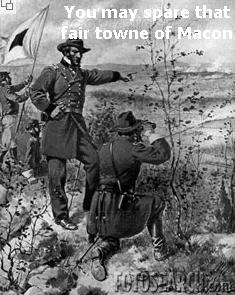 "...You may spare that Faire Towne of Macon..." General Sherman was kind enough to spare Macon. Why won't Moreland-Altobelli? 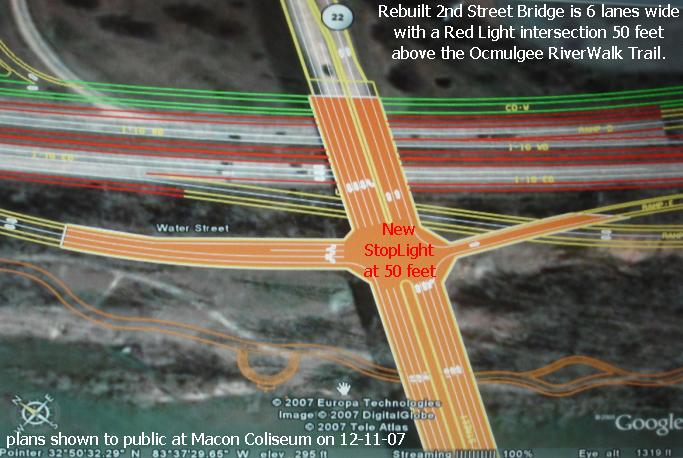 Second Street Bridge will be torn down and rebuilt 6-Lanes wide.  2
(two) new
intersections will add 20 new stop
lights. This will impede traffic to a
standstill on the
bridge. 2
(two) new
intersections will add 20 new stop
lights. This will impede traffic to a
standstill on the
bridge. 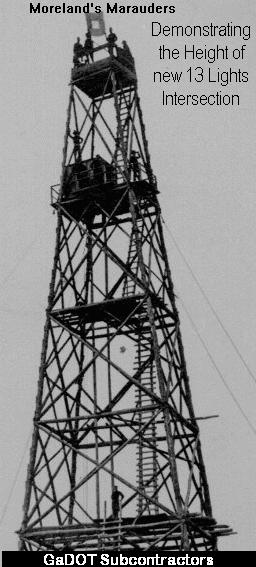 People may be able to enjoy (?) the view when stopped at the Traffic Light if the railings are short enough.  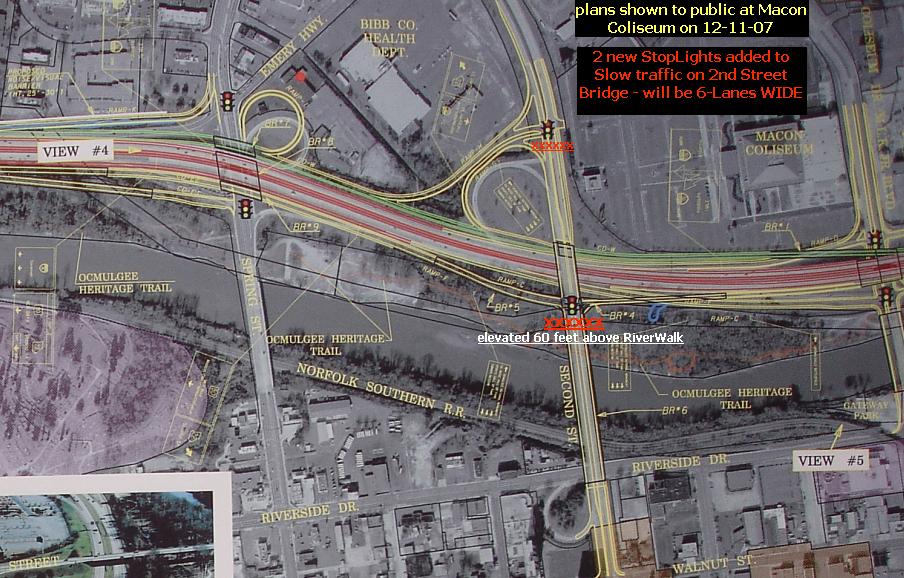 |
||
GaDOT: Finishing what Sherman started 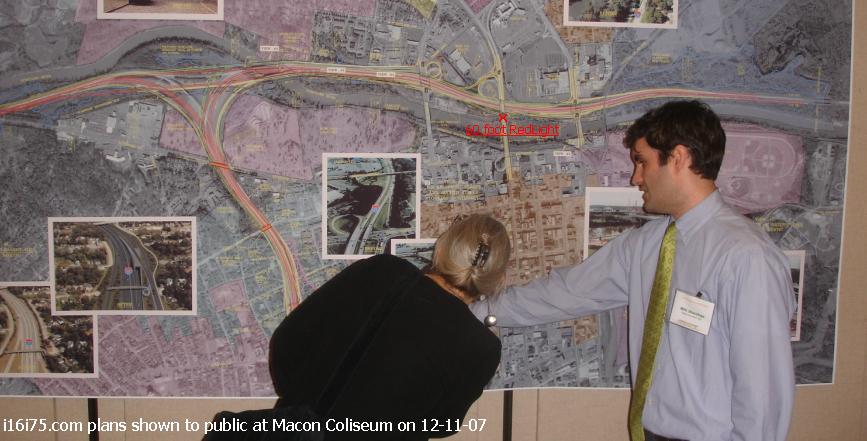 |
||
|
23
Lanes WIDE !
|
||
 This project is 23 lanes wide in some places including the "break-down" lanes. Don't you feel safer now? |
| |
||
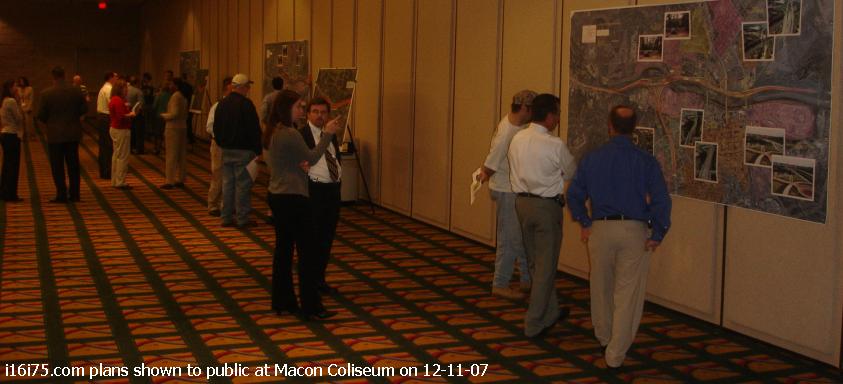 |
||
| http://www.i16i75.com/ A
Public Hearing was held on Tuesday
December
11, 2007
at the Macon Centreplex Ballroom (200 Coliseum Drive,
Macon, Georgia,
31217) from 4:00 p.m. to 7:00 p.m.
|
||
|
The draft
Environmental
Assessment (EA)
was approved by FHWA
on October 22, 2007. Copies of the document will be
available for
public review beginning November 26, 2007 at the
following locations:Georgia
Department of Transportation, Office of
Environment/Location, 3993 Aviation Circle, Atlanta, GA
30036.
Georgia
Department of Transportation Macon Area Engineers
Office, 4499 Riverside Drive, Macon, GA 31210.
Booker
T.
Washington Community Center, 391 Monroe Street,
Macon, GA 31201.
Macon
City
Clerks Office, City Hall, 700 Poplar Street,
Macon, GA 31201.
Washington
Memorial
Library, 1180 Washington Avenue, Macon,
GA 31201.
Bibb
County
Library, Shurling Branch, Shurlington Plaza,
1769 Shurling Drive, Macon, GA 31211.
GDOT
has held
several coordination meetings with the
Pleasant Hill neighborhood.
|
||
GaDOT Monster has
Firends:  Moreland-Altobelli Monster has paws on every Georgia Politician, His Brian Powers over every Bureaucratic Pawn, His Slurping Thirsts for GA Gas Tax Monies. His Vampires suck fresh blood from GDOT to reinvigorate his incestuous relationship with that big fat cash-cow. |
|
|
||
|
Don't you believe them for a minute. Don't you dare believe them. The state's high-level elected officials were merely feigning shock - shock, they said - last week upon learning of the massive disarray in the state's Department of Transportation. To briefly recap the news made by new DOT Commissioner Gena Abraham last week, the agency has been so wildly mismanaged for so long the staff couldn't even tell her how many projects were on the books. The initial number given to her was 1,100 projects, but that number later mushroomed to more than 9,000, with about 2,500 projects listed as active. Beyond that, Abraham's poking around in the agency's books - insofar as such poking around is possible, given that the agency has five separate computerized accounting systems, only a couple of which are integrated - revealed that just one of the agency's groups of projects is more than $4 billion above initial cost estimates. In a shameless bit of stagecraft last week, Perdue called journalists from The Atlanta Journal-Constitution into his office - after meeting behind closed doors with Abraham and the DOT board - so that he and board members could tell the newspaper the new commissioner's revelations marked the first time, the very first time, that they'd heard anything about the transportation agency's obviously longstanding mismanagement. "But the first step toward doing better is acknowledgment of that," the governor told the Atlanta newspaper, offering up a bathos-soaked bromide of contrition. It wasn't long before the state's legislative heavy-hitters were chiming in with their own pusillanimous tut-tutting. Here, for instance, is Glenn Richardson, speaker of the House, talking with InsiderAdvantageGeorgia.com: "The problems within DOT that have been uncovered after years of buildup are the fault of no particular person but rather of a flawed system." House Majority Leader Jerry Keen, R-St. Simons, also talking with InsiderAdvantage.com, said "(i)t's obviously time for more openness from the Department of Transportation ... ." Another legislative denizen to go on record with InsiderAdvantage.com, Senate Transportation Committee Chairman Jeff Mullis, R-Chickamauga, commended Abraham for her "due diligence to make DOT work better. And I do believe what they're finding is part of the historic culture that proves that change is in order. ... I will be working to see how we can work with Commissioner Abraham to get DOT back on the right track." Truth is, Mullis, Keen, Richardson, Perdue and a host of other state legislative leaders know exactly why DOT has - to turn Mullis' phrasing around a bit - been on the wrong track, and been on it for so long. Put plainly, it's their fault. Taking even a cursory look at the campaign contribution reports filed by Perdue, Richardson and this state's other top legislative leader, Lt. Gov. Casey Cagle, who presides over the state Senate, reveals that they've taken money as late as last year - an election year, as you'll recall - from a virtual parade of road contractors, construction companies, developers, oil companies, real-estate agents, the trucking industry and others with direct or indirect interests in maintaining the status quo at what has for years been a road-centric Georgia Department of Transportation. Clearly, one way to keep those donors' checkbooks open was to ensure that road projects that kept contractors in business, that made it easier for commuters to get to their suburban homes, that kept people pulling up to gas pumps, continued to get put on the DOT's agenda. So maybe it's no real surprise that no one at DOT could say how many projects were in the works. It's certainly no surprise the governor and many of this state's most powerful legislators haven't been particularly interested in looking at the agency's books. And they certainly weren't ready for Abraham to rub their noses in the DOT ledger. So, when that happened, what was left for any of them to do but feign surprise, blame the problems on nebulosities like a "historic culture" or a "flawed system," and cross their fingers that the public would buy their act? Don't
you do it.
Don't you dare do it. • Jim Thompson is editorial page editor of the Athens Banner-Herald. He can be contacted at (706) 208-2222 or by e-mail at jim.thompson@onlineathens.com. Published in the Athens Banner-Herald on 121607 |
||
| |
||
|
|
||
| http://www.preservenet.com/freeways/FreewaysTear.html |
| CAUTION
Macon |
||
|
Posted on Fri, Nov. 03,
2006
http://www.macon.com/mld/macon/news/15916008.htm Road plan gets mixed reviews By Keich Whicker TELEGRAPH STAFF WRITER An after-work crowd gave the design of the $250 million interchange project for interstates 75 and 16 mixed reviews Thursday. About two dozen officials from the Georgia Department of Transportation and the engineering firm Moreland Altobelli Associates Inc. worked a room at the Macon Coliseum where large maps hung on the wall. They answered questions and listened to comments about the proposed construction. The event, billed as an information session for the public, attracted a combination of residents and commuters, many of whom charged that none of the public's previous comments had been taken into account in the current design. "The DOT and Moreland Altobelli never listen to anybody," Macon resident Nick Pietrzak said. "They say they listen, but they never listen to anything you say." But Harriet Eason, who commutes downtown for work, said something needs to be done about the interchange because it's unsafe. "Every day when I pass through there, there's just not enough room for all the incoming traffic," she said. "We just had a visitor who said they were happy to have lived through it ... that it was more dangerous than anything they've been through in Atlanta," where they live. The DOT's plan to spend about $250 million to rework the interchange - and several miles of the pair of interstates flowing into the interchange - has been in the planning stages for years. Those plans have generated plenty of controversy, with critics charging the current design is much too big and negatively impacts the historic Pleasant Hill neighborhood. Proponents of the project say the size of the project's footprint is necessary because of expected increases in traffic volume and the project's overall goals. Both sides largely agree something should be done to the interchange, which is considered dangerous because of the way motorists must merge quickly to make their exits, but they disagree about how best to do that. Calling the project a gross example of "government waste and government arrogance rolled into one," Macon City Councilman Rick Hutto said the project swells in size each time it comes back from the drawing board. "Each time we meet with them, they come back and the project has gotten bigger and more expensive," he said. "So what's the point of having these meetings?" Ben Buchan, a DOT engineer, said the project has evolved. "This project has changed all along," he said. "In some places it got bigger, in some places it got smaller." Buchan said the DOT and engineers try to accommodate as much of the public's input as they can, but in some cases the public's wants and desires directly conflict with project's goals and requirements. "Safety is the biggest issue, but there are other things we have to address," he said. "If we don't take care of those, then we have a problem. There are certain things (construction-wise) that we have to do to accommodate the (increase in) traffic." The DOT said there were more than 1,300 traffic accidents at the interchange between 2001 and 2003 that resulted in 641 injuries and three fatalities. Those statistics are 40 percent higher than rates in similar interchanges across the state, Buchan said. Another DOT official talking to a resident Thursday called the interchange "the most dangerous interchange in the state." Additionally, engineers say they are interested in eliminating poor merging conditions, poor sight distance and congestion around the two interstates. A handful of residents, voicing their concern about the speed that many cars enter the interchange, suggested the DOT consider using signs and local law enforcement to create a "restricted speed zone" that would cut down on accidents. Others encouraged the DOT to extend Interstate 475 so that it loops all the way around Macon, creating a perimeter road similar to Interstate 285 around Atlanta. Overall, most were concerned with the project's substantial footprint, which calls for the removal of about 35 buildings - many of them Pleasant Hill homes - added vehicle lanes, extended ramps and the redesign of both the Second Street and Coliseum Drive bridges. But Peter Givens, who was born in Pleasant Hill and has worked with the neighborhood and the DOT on the project, said residents think the DOT worked to address their concerns. "We asked for this," he said, indicating the area where a park would be built to provide a buffer between the neighborhood and the roadway extensions. "(The residents) are happy with it because they are going to be fairly compensated for their property." DOT officials said right-of-way acquisition could begin in 2008, with actual construction scheduled to start in 2010. Telegraph staff writer Travis Fain contributed to this report. To contact writer Keich Whicker, call 744-4494 or e-mail kwhicker@macontel.com Comments http://pod01.prospero.com/n/pfx/forum.aspx?msg=459&nav=messages&webtag=kr-macontm What are the current accident rates now that GaDOT finally improved the signs leading up to the interchange? Of those accidents, how many were due to excessive speed? And since this project has been ongoing for a number of years, how has the projected traffic "increase" compared to the actual traffic data? ·Posted by: SavetheGreenway 11/3/2006 8:35 AM I agree something needs to be done. I 475 needs to be extended from I75 north of Macon eastwardly to I16. Or extend I475 from I75 south of Macon northerly across the river to I16. Why demolish the infrastructure in the city when a bypass will ultimately be needed.The GDOT is using the same faulty reasoning and tunnel vision that resulted in the mess we have now.I 475 is full of traffic now, traffic that would be going thru Macon if we did not have a bypass.Bypasses reduce the traffic in the city and the need for extensive construction within the city. Posted by: ·[] 11/3/2006 1:31 PM Wow, only two comments for a project that will destroy the Greenway and Macon tourism, but when someone wants to put a path through a cemetery the whole city is up in arms! ·Posted by: ·[] 11/3/2006 11:09 PM Do you think that if we completed the Fall line freeway it would alleviate some of the congestion at the 16\75 interchange,perhaps? ·Posted by: Michael Kelly |
||
| Images
of
DOT design goals matrix now posted at: http://www.macon-bibb.com/CAUTION/i16i75/GOALS_DOT.jpg http://www.macon-bibb.com/CAUTION/i16i75 These GDOT actions appear to be arbitrary and capricious. Hutto mentioned this. What does Linnenkohl have to say about this? The state Department of Transportation has a tin ear when it comes to listening to community concerns and considering alternate proposals Good Editorials by Telegraph Posted on Fri, Apr. 16, 2004 http://www.macon.com/mld/macon/news/opinion/8441220.htm Posted on Fri, Dec. 17, 2004 http://www.macon.com/mld/telegraph/news/opinion/10433519.htm DOT engineers should listen to the citizens |
||
|
CAUTION Macon from a report in Macon Telegraph by Travis Fain 11-19-05 p2B I-16/I-75 Intersection Re-Work Proposals Georgia DOT officials and consultants will hold an informational meeting on Monday, Nov 21, 2005 at the Booker T.Washington Center on Monroe Street at 5:30pm. What are the impacts to the Pleasant Hill Neighborhood? Eleven (11) homes will be bulldozed to make room for a wider Interstate, according to recent GDOT plans. "We're strictly going to talk about that neighborhood, and we want comments from that neighborhood," says Ben Buchan, the GDOT head design engineer who works closely with the project - www.i16i75.com |
|
Macon, Georgia - Bibb County's - "Roads Improvement Program" |
| Posted on Fri, Mar. 19, 2004
Residents, officials unhappy with DOT's lack of changes to I-16/I-75 plan By Travis Fain Telegraph Staff Writer
Here's what the Georgia Department of Transportation said has changed with the Interstate 75-Interstate 16 interchange design during the past 14 months: Essentially nothing.
The news was not received happily Thursday by a crowd of about 60 people at a question-and-answer session on the project. The design still calls for 14 lanes just before I-75 crosses the Ocmulgee River, and it still includes several new bridges across the river. The design is still too wide and too high for critics' tastes, and state engineers - who still approve of the design - said the plans are working their way through the federal review process and toward a 2007 construction date.
Several people said Thursday they are upset that alternative designs have been either ignored or dismissed in the year since the project became a hot-button issue. Calls to "go back to the drawing board" continued, but the engineers invited to Jack Ellis' Mayor's Night Out discussion gave no indication such a move was in the works.
Ellis promised to take the issue higher up the chain of command, saying he will write letters and seek meetings with DOT Commissioner Harold Linnenkohl, local DOT board representative Ward Edwards and U.S. Rep. Jim Marshall, D-Ga. But Ellis also said he has discussed the project with Gov. Sonny Perdue and that it may be too late to change designs for the more than $200 million project. Even so, the mayor promised to "let them know the dissatisfaction ... and see what can be done, if anything."
Participants Thursday generally agreed that something must be done at the interchange, which is considered dangerous and has been the site of numerous accidents. The disagreement is over whether to proceed with the DOT's current design or explore alternatives proposed by local residents and an outside engineer brought in by members of CAUTION Macon, a watchdog group that focuses on road projects.
Charles Hasty, a project design manager who joined the I-75/I-16 project within the last year, said Thursday he has never seen any of those alternative designs. Other DOT engineers who have been with the project longer have said repeatedly they believe the current design is the best option.
Though most residents spoke against that design Thursday, one woman said it's time to move forward. Sandra Bush said she was part of the local stakeholder committee that helped select the current design several years ago. Despite criticism that public input is being ignored, Bush said it was sought out and considered. "Consensus means you get some of what you want. You don't get all of what you want. ..." Bush said. "There was input."
To contact Travis Fain, call 744-4213 or e-mail tfain@macontel.com.
|
||
|
October 25, 2000 Traffic relief on
the way
By Thomas W. Krause The Macon Telegraph A steady stream of Maconites milled about a conference room Tuesday evening at the Edgar H. Wilson Convention Centre, looking for answers to their questions about a Department of Transportation project that will change Macon's interstate highway system. Two retirees living in the historic North Highland neighborhood off North Avenue had grave concerns over trucks that constantly rumble down Gray Highway on their way to Gray and Milledgeville. "The traffic is just unbelievable," said one homeowner who asked not to be identified. "And they've already ruined our neighborhood with the Kroger. You should have seen how beautiful it was 25 years ago." She hopes the DOT project - expected to renovate the Interstate 75/Interstate 16 connector - would help alleviate much of the area's traffic problems. "If you could see those big log trucks, piled up high," she told DOT engineer Joe Palladi. "If one of those should fall over ..." Palladi said his studies, both scientific and anecdotal, echo the residents' complaints. "You're right," he told the woman. "Everybody gets off at Spring Street. We came by there just a little while ago, and it's already backed up." DOT statistics show daily traffic counts one way are close to 35,000 trips. The expectation is that they will increase to 48,000 cars daily by 2025. But Palladi told the woman that renovations to Second Street at I-16 should help relieve much of the traffic causing the complaints of the North Highland residents. Special connector roads parallel to the interstate will help separate traffic and provide easier exiting from the highway. More exits will help redistribute the traffic as it heads out of Macon. The project also involves widening the interstate from two to three lanes in each direction, renovations to the Otis Redding Bridge on Martin Luther King Jr. Boulevard and restructuring the point where I-16 and I-75 connect. The project will also include construction of new bridges. DOT officials have not said how expensive the project might be. G.E. McClendon, who lives on Buena Vista Drive in central Macon, said he owns a television sales and service business. Several times a day, he has delivery trucks head through the I-16/I-75 area, and he's well aware of the congestion. He showed up at Tuesday's information meeting to hear about the plans for change. By the time he left, McClendon's only concern was the time factor. He said he wished the DOT could begin right away. "When Spring Street gets clogged up, you'll stand there for I don't know how long," he said. "You'll be backed up all the way to the river." Palladi said the DOT is expected to begin acquiring land in 2002. By 2004, construction should begin. The project will not be completed until 2007, at the earliest. Although the project has been in the works since the 1980s, Palladi said other projects have taken much longer. "I've worked on projects as old as 40 years old," he said. "While (this project) is taking longer than some may desire, it is not out of the ordinary for a project of this size." The DOT considers the I-16/I-75 area to be a priority, Palladi said. Studies show that traffic is becoming increasingly dense in the area - which immediately causes a safety concern. Along I-75, accident rates are 33 percent higher than the state average on similar routes, he said. On I-16, the accident rates are 20 percent higher than the state average for similar routes. "It's most critical that the safety of operation on the interstates is looked at," Palladi said. This construction project also marks one of the first uses of an innovative DOT program designed to get public input before beginning major projects. Before planning began, the DOT set up a citizens committee of 18 local business owners, historians, environmentalists and average residents. That group was involved in all planning decisions. Members of the citizens committee were present Tuesday to help answer questions. Paul Nagle, the outgoing executive director of the Greater Macon Chamber of Commerce and a committee member, said all committee members were educated about why the DOT is required to take the actions it does. Committee members also know how all the decisions were made on this project. They can, therefore, answer questions for fellow citizens of Macon. Palladi said this type of local involvement is not always possible, but it has proved very useful in some situations. The I-16/I-75 project, for example, needed local input because of the sensitive nature of the area involved. The project site includes historic areas, the river and its planned greenway, the Macon Coliseum and convention center and residential areas and wetlands. "Everything you don't want on a road project is here," Palladi said. To contact Thomas W. Krause, call 744-4477 or e-mail tkrause@macontel.com . http://www.macontelegraph.com/content/macon/2000/10/25/local/1025traffic.htm
|
||
|
|
||
| Date: Thu, 15 Apr 2004 17:47 From: Dan Fischer <fischer_dp@Mercer.EDU> Subject: Request for Meeting - Advisory Committee of the I-16/I-75 2ND COPY! To: harold.linnenkohl@dot.state.ga.us Cc: "Palladi, Joe" <Joe.Palladi@dot.state.ga.us>, "Buchan, Ben" <Ben.Buchan@dot.state.ga.us>, David Grachen <David.Grachen@fhwa.dot.gov>, "Katy Allen," <Katy.Allen@fhwa.dot.gov>, Charles Richardson <crichardson@macontel.com>, Travis Fain <tfain@macontel.com> I served as a member of the Citizens Advisory
Council for
the I-16/I-75
Interchange, which last met on September 28,
2000. I and nine other
members of that committee have begged the Georgia
Department
of
Transportation (GDOT) to reconvene the committee to
consider
design
options suggested by citizens adversely affected by
the
proposed
interchange and by Joseph Passoneau, a nationally
renown
expert on
innovative, context-sensitive design engaged by
NewTown
Macon (our
correspondence of April 3, 2003, May 8, 2003, and
June 9,
2003 is
attached). Many committee members were
uncomfortable with
the sheer
scale of our final recommendation; we believe that
the
alternatives
offered have the potential to substantially reduce
the cost
and scale of
the project, lessen negative impacts to adjacent
neighborhoods and on
the city at large, and improve overall safety and
utility. We are
incensed that GDOT would used the Citizens Advisory
Council
as an excuse
for ignoring subsequent citizen input. As our
efforts
of the past year
to reconvene the council have been of no avail, I
ask you to
intervene
on our behalf, and on that of concerned citizens of
Bibb
County; an
opportunity to revisit the design is critical given
the
decision by
Governor Perdue to fast-track the project.
The proposals that surfaced after our meetings
suggest a
logical and
extremely innovative concept that was not presented
by GDOT
or, I'm
ashamed to say, members of the CAC during our
deliberations:
treating
the local interchanges providing access to I-16
(Spring
Street, 2nd
Street, and Coliseum/MLK) as functional
couplets. This
relieves the
need for each interchange to have independent
utility in
satisfying all
access/egress movements. It also provides an
elegant means of
eliminating the most dangerous merging maneuvers,
including
new ones
such as the 2nd Street on-ramp/Spring Street exit
conflict
in the
current GDOT plan, without the need for an
excessive number
of new lanes
or the high overpass - both subjects of the
greatest concern
to
citizens. Such alternatives promise to
dramatically
reduce the cost of
the project while providing a much safer
alternative (the
project is
out-of-scale for the area, as most Maconites are
unaccustomed to 14-lane
highways; this in and of itself creates an
unnecessary
hazard). An
extremely important consideration not present
during earlier
considerations is the new Ocmulgee Heritage Trail
and
riverside park, a
hallmark achievement for our community, which will
be
virtually
obliterated by an expansion of the scale proposed.
In light of the above, it is imperative that GDOT
revisit the
interchange design, considering neighborhood
concerns and
the sheer
physical/visual impac t and cost of the proposed
expansion.
Daniel P. Fischer, Members of the Advisory
Committee
of the I-16/I-75
Improvement Project
489 Ashville Drive,
Macon GA 31210
Office: (478) 301-2489
Home: (478) 477-3875
Attachments: correspondence with GDOT
April 3, 2003
To: Mr. Joseph P. Palladi, P.E. State Urban Design
Engineer
Subject: Request for Meeting - Advisory Committee
of
the I-16/I-75
Improvement Project
Dear Mr. Palladi:
The Advisory Committee of the I-16/I-75
Improvement
Project requests
that G-DOT arrange a late afternoon or evening
meeting with
the
committee in Macon on a day of your choosing for an
update
as to the
status of the project.
Our last meeting took place on September 28, 2000.
We were
notified in
your letter of June 7, 2002, that a meeting with
the
committee was
anticipated during the summer of 2002; that meeting
failed to
materialize. Your letter of October 31, 2002
thanked us for
our patience
and stated that our assistance was critical in the
coming
months, as
several important project decisions need to be
made. We
agree, and feel
strongly that our continued service will be of
benefit to
both the
Department of Transportation and the community.
We are committed to assisting the Department in the
improvement of I-16
and the I-16/I-75 Interchange in a manner that
benefits the
community.
We look forward to your early response with a
meeting place
and date.
Sincerely,
Members of the Advisory Committee:
Maryel Battin
Lynn Cass
Connie Mac
Darnell
Jim David
Eugene
Dunwoody Sr.
Dan Fischer
Brian McDavid
Regina
McDuffie
Anita Ponder
Johnny Wingers
Followup Email, May 8, 2003:
To: Mr. Joseph P. Palladi, P.E. State Urban Design
Engineer
Subject: Re: Request for Meeting - Advisory
Committee of the
I-16/I-75
Improvement Project
Dear Mr. Palladi:
We have received no acknowledge of or response to
our letter
of April 3,
2003. Please advice as to the status of
our
request for a meeting.
Thank you.
Members of the Advisory Committee of the
I-16/I-75
Improvement Project
Followup, Monday, June 09, 2003
To: Buchan, Ben
Cc: Palladi, Joe; Grachen, David (FHWA); Katy
Allen,
Subject: Re: Request for Meeting - Advisory
Committee of
the I-16/I-75
Improvement Project
Dear Mr. Buchan:
I understand that you have replaced Joe Palladi as
State
Urban Design
Engineer. I assume you also succeed him as the
I-16/I-75
Project team
leader (if not, please advise so I can direct
correspondence to the
appropriate official). I am, therefore,
forwarding a
request made to
Mr. Palladi by Members of the Advisory Committee of
the
I-16/I-75
Improvement Project.
Our request was initially submitted on April 3,
2003, with a
followup on
May 8, 2003. To date we have not had the
courtesy of
an acknowledgment
or reply. We hereby formally
repeat our
request for a meeting in
Macon for an update as to the status of the
project. I thank you in
advance for your timely attention to his request.
Members of the Advisory Committee of the
I-16/I-75
Improvement Project
[Copies of previous emails incorporated]
Mr. Palladi's response to June 9, 2003
correspondence:
We are in the process of responding to your
request. I will
still be
involved through the Concept approval. Then, Mr.
Buchan
takes over the
responsibilities to finish the plans, assuming an
environmental document
is approved. A written letter should
be forthcoming to all CAT members [a letter was
forthcoming,
but no
meeting has been scheduled to date - dpf].
|
|
Solve the related: |
| under construction by Lindsay Holliday |